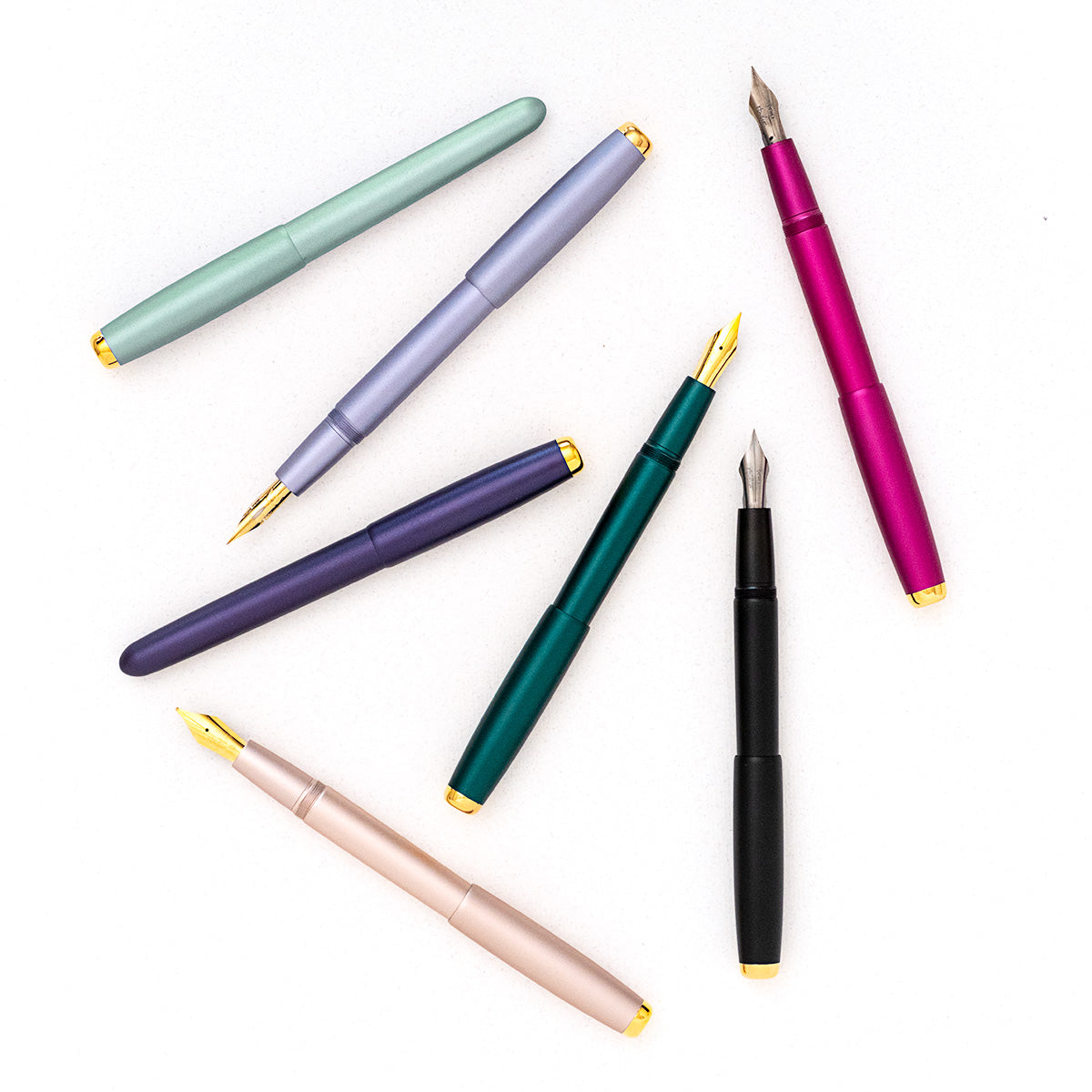The Studio Fountain Pen
A brief guide to get you started with your new pen.

ABOUT THE STUDIO FOUNTAIN PEN
Our Studio Fountain Pen is crafted from anodised aluminium, with a gold-plated finial for a touch of elegance.
- Length capped – 145mm
- Length uncapped – 105mm
- Pen barrel diameter – 14mm
- Weight – 30g
Absolutely! Our Studio Fountain Pen works beautifully for left-handed users. However, as with most fountain pens, smudging can occur depending on your writing style.
Fountain pen nibs are usually ready to use straight away. If you notice any ink flow issues, we recommend giving your pen a flush with warm soapy water or using our Nib Cleaning Solution for best results.
For tips, check out our visual guide and video tutorial.
We recommend MD Paper for its smooth finish and fountain pen-friendly qualities – it prevents bleeding and ensures your lines are crisp and clear.
ALL ABOUT INKS
Our Studio Fountain Pen works beautifully with all fountain pen inks, and you’ll find a splendid selection here.
Avoid using calligraphy-specific ink, as it can clog the pen.
Yes, you can! The Gold and Sterling Silver plated nibs resist corrosion, so it’s safe to leave ink in the pen.
The Pro-Flex nib, however, is prone to corrosion. For the best longevity, we recommend either removing the Pro-Flex nib and drying it between uses or flushing the pen with distilled water after each use and drying it thoroughly. Luckily, the Pro-Flex nib is easy to replace if needed.
Our Studio Fountain Pens are refilled using an ink converter. You can see exactly how it’s done here.
Yes! If you prefer, you can use a standard international-sized ink cartridge (long or short) instead of the ink converter.
ALL ABOUT NIBS
If you’re unsure which nib is best for you, take a look at our handy nib guide to help you decide.
All our nib units unscrew from the pen for easy swapping. To change nibs:
- Remove the ink converter.
- Hold the nib and feed (the black part under the nib) between your fingers.
- Twist anti-clockwise to unscrew the nib unit.
Paper acts as a natural abrasive, so with regular use, the nib will polish itself over time.
If you’d like to speed up the process, you can use micromesh – a fine abrasive that goes up to 12,000 grit. Carefully sand the iridium tip of the nib, starting with a lower grit (e.g., 1200–2400) and working your way up for a buttery-smooth writing experience.
CARING FOR YOUR STUDIO FOUNTAIN PEN
We recommend thoroughly flushing your fountain pen before its first use. This removes any manufacturing oils on the nib that could hinder ink flow. You can use:
- Nib Cleaning Solution
- Distilled water
- Water with a small drop of dish soap
Store your Studio Fountain Pen capped and in a horizontal position to prevent ink from drying out or pooling unevenly. For longer periods of storage, clean and dry the pen to ensure it’s ready for use when you pick it up again.
TROUBLESHOOTING
There might be dirt, grease, or dried ink on the nib. To fix this, soak the nib in warm, soapy water for a few minutes, rinse thoroughly, and reassemble the pen with the cartridge.
Air bubbles trapped in the ink converter can also disrupt ink flow. To resolve this, hold the pen upright so the air rises to the top, then gently twist the cartridge clockwise to push the air out.
If the pen is leaking from the nib, it could be because the ink converter has been overfilled. Overfilling can create excess pressure inside the pen, pushing ink out through the nib when it’s not in use. To prevent this, leave a little space at the end of the converter when filling to allow for air.
If the leak is coming from the converter, double-check that the silver part at the top of the converter is tightly screwed on. It can sometimes loosen with repeated twisting and refilling.
